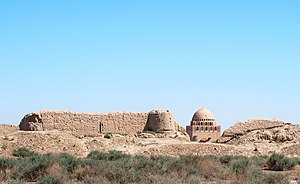Our website is made possible by displaying online advertisements to our visitors.
Please consider supporting us by disabling your ad blocker.
Mongol invasion of Khorasan
| Mongol conquest of Khorasan | |||||||
|---|---|---|---|---|---|---|---|
| Part of the Mongol conquest of the Khwarazmian Empire | |||||||
 The walls of the city of Merv, which never recovered from the Mongol conquests; the tomb of Ahmad Sanjar can be seen through a gap in the ruined fortifications. | |||||||
| |||||||
| Belligerents | |||||||
| Mongol Empire | Khwarezmian Empire | ||||||
| Casualties and losses | |||||||
| Light | Devastating | ||||||
The Mongol invasion of Khorasan took place in 1220–21, during the Mongol conquest of the Khwarazmian Empire. As the Khwarazmian Empire disintegrated after the capture of the large cities of Samarkand and Bukhara by the Mongol Empire, Shah Muhammad II fled westwards in the hope of gathering an army. Genghis Khan ordered two of his foremost generals, Subutai and Jebe, to follow the Shah and prevent any such Khwarazmian resurgence; meanwhile, he sent his youngest son Tolui south to subjugate any resistance.
The region Khorasan contained Silk Road cities such as Merv, Nishapur, and Herat, which were among the largest and richest in the world. Tolui systematically besieged and captured them in turn, pillaging their wealth and executing their inhabitants. Although modern historians regard the figures of medieval chroniclers to be vastly exaggerated—one account has 2.4 million people killed in Nishapur alone—the figures reflect a social catastrophe so extreme the local populations found it difficult to quantify their loss.
Previous Page Next Page


